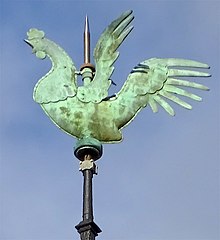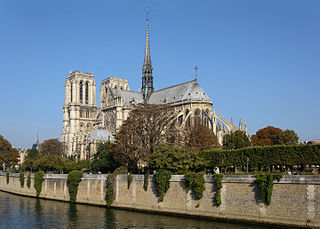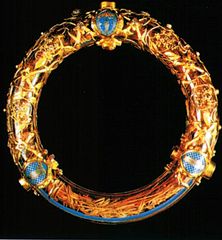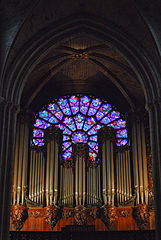
At Notre-Dame de Paris, the fire alarm went off shortly after 6:00 p.m. on Monday, April 15th, but no fire was found. A computer glitch showed the fire location in the wrong place. A second alarm went off at 6:43 while the fire spread from the roof at the rear of the cathedral. In less than an hour, flames engulfed the spire, which collapsed thirteen minutes later.

There was a metal rooster at the top of the spire. The archbishop installed it in 1935 with relics of St. Denis and St. Genevieve, the patron saints of Paris, along with a piece from the Crown of Thorns housed inside. The archbishop called the rooster reliquary a spiritual lightening rod of protection. Gone now
The cathedral’s wooden frame was called The Forest, because the structure was made from 5,000 oak trees, the product of 52 acres of forest cut down in the 12th century. In one sense, the frame is irreplaceable, because today there are no trees of the same caliber.

The cathedral is over 850 years old, constructed between the years 1163 and 1345. It’s 426.5 feet long; 157.5 feet wide, and almost 115 feet high. The thin walls with glass windows are supported by flying buttresses. The famous gargoyles disguised drain pipes that discharged thousands of tons of water to keep so the water wouldn’t collect and weigh down the roof. Presently, there are plans to spread a custom made peaked tarpaulin across the destroyed roof to prevent further water damage while restoration takes place.
The full extent of the damage won’t be known for some time, but the fact that the structure still stands is astonishing. If the fire had been extinguished 30 minutes later, it’s doubtful the structure would have survived.
Guardian News put together a video showing Notre Dame before and after the fire.

RESCUED TREASURES
The Crown of Thorns
Father Jean-Marc Fournier, chaplain of the Paris Fire Department, retrieved the famous Crown of Thorns, believed to be the crown Jesus wore for his trial and crucifixion. The rescuers broke the relic’s protective covering. An official provided the secret code to release the relic completed the rescue.
The Crown came to Notre Dame in the 13th century when King Louis IX purchased the Crown and a fragment of the True Cross from Baldwin II of Constantinople. Louis brought the relics to Paris. At the entrance to Notre Dame, he took off his royal attire. Clad in a simple tunic and with bare feet, Louis brought the Crown of Thorns into Notre Dame. In 1297 Louis was declared a saint.

The Choir Organ
The Choir Organ also survived. The instrument has 8,000 pipes, 115 stopes, and 5 keyboards. It underwent a full restoration in 2013 in celebration of Notre Dame’s 850th anniversary. The organ dates to the 1730s when it was reconstructed by Francois Theirry. Of the 8,000 pipes, 900 are historic. And of the the 900 historic pipes, 12 predate the 1730s reconstruction. The organ now is fully electrified and has digital controls. If you’re wondering what an organ of this size sounds like, tune into Bach’s Toccata and fuga in d minor.
The organ suffered water damage, but was saved by the water firefighters sprayed onto the pipes which kept them from melting. The full extent of damage isn’t yet known.

Gothic cathedrals were designed to emulate heaven on earth. The towering nave and stained glass windows brought light and color into a space carved out of stone. Their survival gives a sense of continuity to western culture. Already plans for Notre Dame’s restoration are being drawn. Notre Dame will rise from the ashes, her towers once again helping human spirit soar.
???
Illustrations:
Notre Dame on Fire by Milliped
Rooster by Panageotean Graphics
Southeast View of Notre Dame de Paris
Crown of Thorns by Doomekroon
Organ, Notre Dame by Eric Chan
Organ Console by Pufui PcPifpeg
Aurelien Breeden. “In Paris, Worn-Out Notre-Dame Needs a Makeover.” New York Times. Sept. 28, 2017.
Allison C. Meier. “13 Facts About Notre-Dame Cathedral.” Mental Floss. April 15, 2019.
Ellie Palmer. “The Great Organ of Notre Dame Saved.” Pianist. April 16, 2019.
Karen Zraick and Heather Murphy. “Notre-Dame Cathedral.” New York Times. April 15, 2019

Sandra Wagner-Wright holds the doctoral degree in history and taught women’s and global history at the University of Hawai`i. Sandra travels for her research, most recently to Salem, Massachusetts, the setting of her new Salem Stories series. She also enjoys traveling for new experiences. Recent trips include Antarctica and a river cruise on the Rhine from Amsterdam to Basel.
Sandra particularly likes writing about strong women who make a difference. She lives in Hilo, Hawai`i with her family and writes a blog relating to history, travel, and the idiosyncrasies of life.

